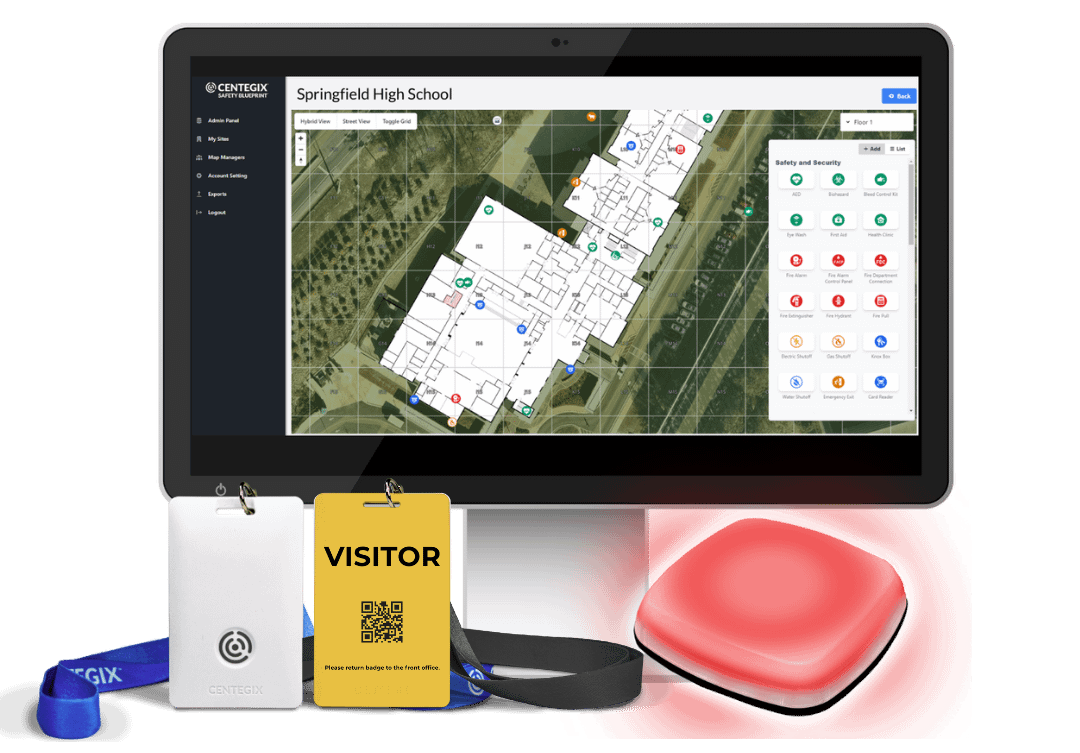In September 2024, Ohio legislators introduced SB313. This legislation would require Ohio schools to comply with the requirements beginning in the 2025-2026 school year. Under SB313, Ohio public and charter schools must implement wearable panic alert systems to accelerate emergency response.
Many US states have passed versions of Alyssa’s Law. This critical legislation aims to accelerate law enforcement response time when life-threatening emergencies occur on school campuses. Ohio’s Alyssa’s Law requires school alert systems that include wearable panic buttons and link directly to law enforcement.
Alyssa’s Law
Alyssa’s Law is named in honor of Alyssa Alhadeff, who was killed in the February 2018 shooting at Marjory Stoneman Douglas High School in Parkland, Florida. Her parents founded Make Our Schools Safe, which aims to “empower students and staff to help create and maintain a culture of safety and vigilance in a secure school environment.” The organization partners with communities and lawmakers to advocate for school safety legislation nationwide.
Alyssa’s Law has been adopted in Florida, New Jersey, New York, Oklahoma, Tennessee, Texas, and Utah. Other states are currently working to pass wearable panic button legislation.
Ohio Senate Bill 313
In September 2024, sponsoring Ohio Senator Michele Reynolds introduced SB313. This bill would require schools to enact Alyssa’s Law and appropriate the funds needed. The bill reads: “Beginning with the 2025-2026 school year, the board of education of each school district and the governing authority of each chartered nonpublic school shall implement a wearable panic alert system at each school facility. Each wearable panic alert system shall be capable of integrating with local public safety answering point infrastructure to transmit 9-1-1 calls and mobile activations and initiating a campus-wide lockdown notification.”
The law requires that schools equip personnel with wearable panic buttons. These devices empower staff members to discreetly initiate emergency alerts when they need assistance or a crisis occurs. SB313 requires that school alert systems be integrated into local first responder agencies. This integration accelerates emergency response by facilitating direct communication between school staff and first responders.
In addition, SB313 requires the following:
- Staff must be trained on the protocol for and appropriate use of the panic alert device.
- Schools must make all security data (cameras, maps, access control) available to local law enforcement agencies and coordinate with these agencies to provide access to school campuses.
- Data regarding school infrastructure and schematics should be confidential, with several exceptions.
How Do Ohio Schools Comply with Alyssa’s Law Requirements?
To comply with Ohio’s Alyssa’s Law requirements, schools must purchase and implement school safety solutions that include wearable panic buttons and integrate with local first responder agencies. The CENTEGIX Safety Platform™ is designed to perform precisely these functions and comply with Alyssa’s Law. In everyday and extreme emergencies, CENTEGIX’s incident response safety solutions empower school staff to request immediate help and accelerate emergency response.
CrisisAlert™
Every second matters in an emergency. Emergency response protocols go into effect immediately when a staff member initiates an alert using their CrisisAlert wearable panic button.
CrisisAlert:
- Features campus-wide emergency notifications using strobes, desktop screen take-overs, and intercom announcements
- Integrates with public safety answering point infrastructure to communicate emergencies directly
- Facilitates real-time coordination among first responder agencies
- Provides critical information in real time to designated school personnel
- Immediately transmits critical information such as floor plans and alert location to assist first responders during emergencies
- Enables staff to request help discreetly, thus preventing further escalation of an ongoing safety incident
- Provides full campus coverage, indoors and outdoors, on private, installed networks that don’t rely on Wi-Fi or cellular service
Safety Blueprint™
Safety Blueprint is CENTEGIX’s critical incident response mapping solution. It provides the real-time data first responders need to respond to emergencies efficiently and effectively. Having situational awareness relative to where an alert was initiated can accelerate law enforcement and medical team responses.
Safety Blueprint:
- Provides precise locations of safety assets, including automatic defibrillator devices (AEDs), first aid kits, fire alarms, fire extinguishers, and other emergency equipment
- Shows evacuation routes
- Provides visual data about a school’s entire campus and facilities
- Can display which camera’s are in the vicinity of an alert to enable observation of critical incidents in real time
- Helps schools reduce response times
Ohio Schools Increase Safety and Achieve Alyssa’s Law Objectives Using CrisisAlert Wearable Panic Buttons
Ohio school districts are already using CENTEGIX Safety Platform solutions to establish a culture of safety and enhance emergency response. Cincinnati’s Princeton City Schools recently implemented the CENTEGIX Safety Platform. According to Superintendent Elgin Card, “In the fall of 2022, we had a pretty big hoax, and it was tough for many people.” In response, Princeton City Schools purchased and implemented the CENTEGIX Safety Platform.
All 777 staff members across the Princeton City Schools’ 11 schools have been trained on the system and are equipped with a CrisisAlert badge. According to district parent Lisa Flacke, CrisisAlert is “a great way to give the teachers a way to get a quick response and for us to be more proactive about what’s happening.” CENTEGIX school safety solutions have empowered Princeton City staff to communicate instantly with local emergency responders and gain an increased sense of safety.
In Broadview Heights, school staff feel empowered by their CrisisAlert badges. “As soon as an emergency arises, we press our button,” says Stephanie Buda, a science teacher at Brecksville-Broadview Heights High School. “It’s very reassuring to know that in any circumstances, the administration, the entire team, will be at my room or at my location within a minute or sooner.” CENTEGIX school safety solutions also provide support during everyday emergencies. Buda adds: “I have a student with a medical need that needs care beyond what I can provide in my classroom,” Buda said. “I’m able to press my button, and that alerts the administrators to come to the student’s attention.”
In central Ohio, school staff observe that the CrisisAlert school alert system eliminates the delays associated with app-based alert systems. New Albany-Plains associate superintendent Ken Kraemer said, “The ability to notify an administrator quickly, previous to this technology, was, ‘I need to get to my cellphone. I need to get to my classroom phone. I need to find the right number. I need to call that number.” But CrisisAlert’s wearable panic buttons make it possible for staff to request help at the very instant help is needed. CENTEGIX technology eliminates the need for staff members to use their cell phones, walkie-talkies, or other cumbersome technologies.
CENTEGIX CrisisAlert Across Ohio
Many Ohio districts are pursuing compliance with potential impending Alyssa’s Law legislation by implementing CENTEGIX school safety solutions:
- Galion City Schools used 2023 grant funding to purchase a five-year contract for CENTEGIX CrisisAlert.
- Buckey Local Schools implemented CrisisAlert in 2023.
- Loudonville-Perrysville Exempted Village School District used grant funds to purchase CrisisAlert in 2023.
- Akron Public Schools implemented CrisisAlert in 2023.
Wearable panic buttons facilitate efficient, effective emergency response and help create a culture of safety in Ohio schools. Request a demonstration today to learn more about how your district can achieve compliance with SB313 and accelerate emergency response using the CENTEGIX Safety Platform.












